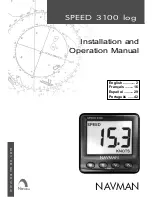
- 3 -
= Undefinierter Zustand
= Non-defined condition
= Etat indéfini
(1) = Normaler Arbeitszyklus
(1)
= Normal work cycle
(1) = Functionnement normal
(2) = Fehlbedienung: Eingangskreis zu
(2)
= Fault condition: Input circuit opened
(2) = Défaut: ouverture prématurée du
früh geöffnet
too early
circuit d'entrée
(3) = Fehlbedienung: Rückführkreis zu
(3)
= Fault condition: Feedback control loop
(3) = Défaut: fermeture boucle de retour
spät geschlossen innerhalb von t
w
closed too late within t
w
trop tardive dans l'intervalle t
w
(4) = Fehlbedienung: Rückführkreis zu
(4)
= Fault condition: Feedback control loop
(4) = Défaut: fermeture boucle de retour
spät geschlossen nach Ablauf von t
w
closed too late after t
w
après écoulement de t
w
t
w
= Wischzeit (Impulszeit)
t
w
= Pulse time
t
w
= temps d'impulsion
Fig. 2: Funktionsdiagramm/Pulse diagram/Diagramme fonctionnel
Installation
The unit must be panel mounted (min. IP 54).
There is a moulding on the rear of the unit for
DIN-Rail attachment.
Operation
Please note for operation:
• To prevent a welding together of the
contacts, a fuse (see technical detail)
must be connected to protect the
output contacts.
• Auxiliary contacts 25-26 and 35-36 are not
to be used for safety circuits
• Use copper wire that can withstand
60/75 °C
• Important details in the section „Technical
Data“ should be noted and adhered to.
• With units for 24 VDC, shorts across the
input contacts between the input circuit
and the feedback control loop or earth
faults in the feedback control loop may
cause damage to the unit. Therefore,the
use of short circuit proof voltage supply
with current limitations is recommended.
Connection and setting
• Connect the input circuit (operating
voltage) to terminals A1 (+) and A2 (-).
• Feedback control loop:
Connect the N/C contact of the relay to be
monitored to the feedback control loop
Y1-Y2 or, if not used link Y1-Y2.
• Set the rotary switch to required pulse
time.
To operate
The input circuit is interrupted (rest
position), the safety contact 17-18 opens
and the auxiliary contacts close. The LEDs
"power" and "out" are not illuminated.
If the input circuit closes, the LED "power"
illuminates. The safety contact 17-18 closes,
the auxiliary contacts open and the LED
"out" is illuminated. After the cycle of the set
pulse time, the contacts revert back to the
rest position (de-energise) and the LED
"out" goes out.
Montage
Le relais doit être installé dans une armoire
ayant un indice de protection IP 54. Sa face
arrière permet un montage sur rail DIN.
Mise en oeuvre
Remarques préliminaires:
• Protéger les contacts de sortie par des
fusibles (voir les caractéristiques
techniques) pour éviter leur soudage
• Ne pas utiliser les contacts de
signalisation 25-26 et 35-36 pour les
circuits de sécurité.
• Utiliser uniquement des fils de cablâge en
cuivre 60/75 °C.
• Respecter les données indiquées dans le
chapitre „Caractéristiques techniques“.
• Pour les relais alimentés en 24 VCC, un
court-circuit entre l'alimentation et la
boucle de retour ou la masse et la boucle
de retour risque de détiorier l'appareil.
Nous vous conseillons donc l'utilisation
d'une alimentation protégée contre les
surintensités et les c.c.
Branchement et réglage
• Amener la tension d’alimentation aux
bornes A1 (+) et A2 (-).
• Boucle de retour:
Câbler les contacts à ouverture des
contacteurs à surveiller dans la boucle de
retour Y1-Y2 ou - quand ce n'est pas
nécessaire - relier les bornes Y1-Y2.
• Sélectionner le temps d'impulsion à l'aide
du commutateur.
Fonctionnement
Si le circuit d'entrée est coupé (position
repos), le contact de sécurité 17-18 est
ouvert et les contacts d'info. sont fermés.
Les LEDs "power" et "out" sont éteintes.
Dès que le PZW est mis sous tension,
la LED "power" s'allume. Le contact 17-18
se ferme et les contact d'info s'ouvrent.
La temporisation commence et la LED "out"
s'allume. Au bout de la temporisation
affichée, les contacts de sortie reviennent
en position repos et la LED "out" s'éteint.
Montage
Das Gerät muss in einen Schaltschrank mit
einer Schutzart von mind. IP 54 eingebaut
werden. Zur Befestigung auf einer Norm-
schiene hat das Gerät ein Rastelement auf
der Rückseite.
Inbetriebnahme
Beachten Sie bei der Inbetriebnahme:
• Vor die Ausgangskontakte eine
Sicherung (s. techn. Daten) schalten,
um das Verschweißen der Kontakte zu
verhindern.
• Hilfskontakte 25-26 und 35-36 nicht für
Sicherheitsstromkreise verwenden!
• Leitungsmaterial aus Kupferdraht mit einer
Temperaturbeständigkeit von 60/75 °C
verwenden.
• Angaben im Kapitel "Technische Daten"
unbedingt einhalten.
• Bei Geräten für 24 V DC können Quer-
schlüsse zwischen Eingangskreis und
Rückführkreis oder Erdschlüsse im Rück-
führkreis das Gerät beschädigen.
Wir empfehlen die Verwendung einer
kurzschlußssfesten Spannungsversorgung
mit Strombegrenzung.
Anschluss und Einstellung
• Eingangskreis (Versorgungsspannung) an
Klemmen A1 (+) und A2 (-) anschließen.
• Rückführkreis:
Öffnerkontakte der zu überwachenden
Schütze am Rückführkreis Y1-Y2
anschließen oder - wenn nicht benötigt -
Brücke Y1-Y2 einlegen.
• Drehschalter auf gewünschte Wischzeit
einstellen.
Ablauf
Ist der Eingangskreis unterbrochen (Ruhezu-
stand), ist der Sicherheitskontakt 17-18 offen
und die Hilfskontakte geschlossen.
Die Leuchtdioden "power" und "out" leuchten
nicht.
Wird der Eingangskreis geschlossen, leuchtet
die LED "power". Der Sicherheitskontakt 17-18
schließt, die Hilfskontakte öffnen und die LED
"out" leuchtet.
Nach Ablauf der eingestellten Wischzeit
kehren die Kontakte in die Ruhelage zurück
und die LED "out" erlischt.
B
U
(1)
w
t
0
1
0
1
0
1
(3)
Eingangskreis
Input circuit
Canal d'entrée
Ausgang
Output
Sortie
Rückführkreis
Feedback Control Loop
Boucle de retour
w
t
(2)
w
t
(4)






























